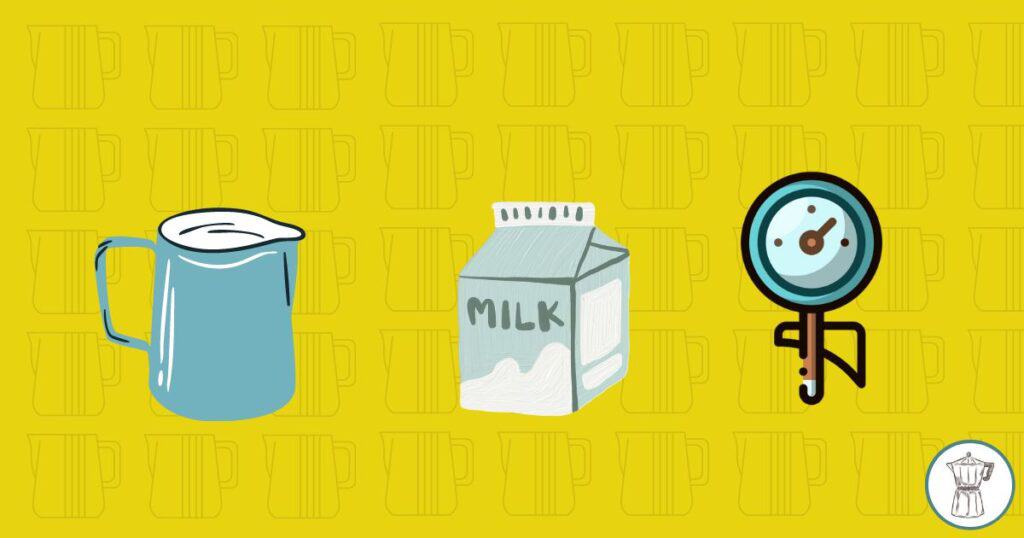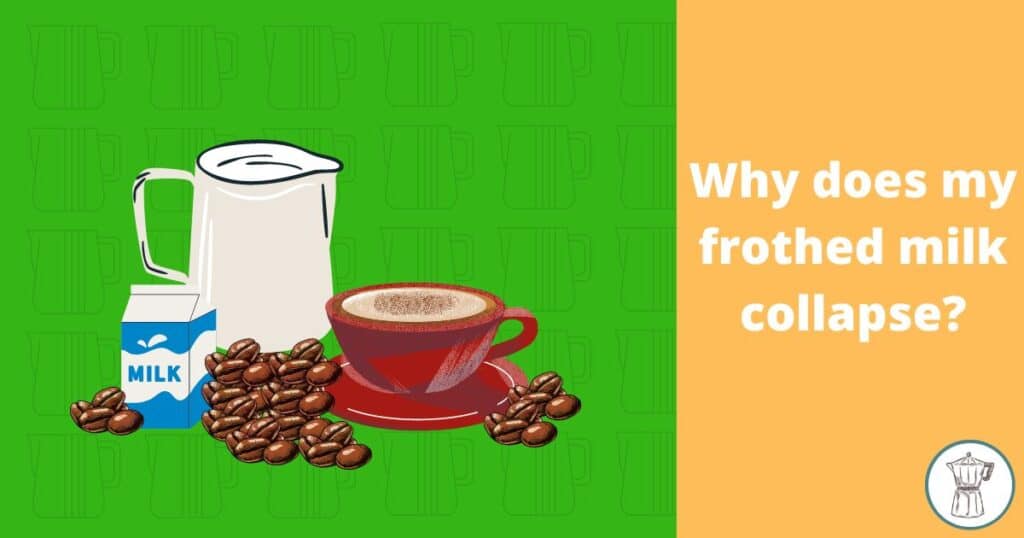Ever wondered ‘Why does my frothed milk collapse?’.
The other day I was trying to make a cappuccino but I was experiencing a MASSIVE problem: the frothed milk would collapse and after 3 attempts I managed to make it float on the top of my coffee. But it got me thinking ‘What makes really frothed milk collapse?’ I did research and I found a bunch of interesting things. Stick around, I’ve compiled a guide on how to froth milk and add it to your coffee the right way.
Let’s dive in.
Key takeaways:
- 6 reasons why frothed milk collapses
- How to froth the perfect milk step by step
- Handy alternatives to milk frother for equally great frothed milk
Six reasons that make your frothed milk collapse
Let’s go through 2 common reasons that make your foam disintegrate.
1. The main reason why does frothed milk collapse?
The reality is that no matter how good you froth your milk, the chances are that it will start collapsing if you don’t drink.
Sam Pinkerton, the Head of Education at Clive Coffee, Oregon states that it’s a matter of time before your foam collapses, the sooner you drink your coffee the less of it will disintegrate.
It all starts with small bubbles that they raise through the air and burst, and the same happens with the bigger bubbles that are becoming smaller and burst. As a result, your frothed milk collapses. This last phenomenon is called Oswald ripening.
2. Milk fat also affects foam disintegration
Normally, milk fat is between 0.1 and 10 micrometres in size. This plays a vital role in how long your frothed milk will be integrated with your coffee.
This is the protein percentage per milk:
- Skim milk – 3.4%
- 1% m.f. milk – 3.4%
- 2% m.f. milk – 3.3%
- 3.25% m.f. milk – 3.2%
- Soy milk – 2.7% (learn how to froth soy milk)
- Almond milk – 0.4%
Full-fat milk is richer in proteins and they typically make richer foam than semi-skimmed milk. And the same goes for plant-based types of milk. For example, I know from experience that almond milk is far from ideal for frothing milk.
Another thing to consider is the temperature of the milk. The hotter it gets the faster the foam bubbles will burst and as a result, the foam will collapse. But if you use cold milk (kept in the fridge) will prolong the time the foam will disintegrate from your coffee.
Here’s a take from a coffee lover on one of the reasons that make frothed milk disintegrate:
I think that the age of the milk is definitely a factor. I used to use an Aeroccinno when I had my Nespresso and towards the end of the carton, the milk would no longer me able to form bubbles and it would collapse so I imagine the milk proteins start to break down with age.
– Histotech93
3. Water coming out of the steam wand
This is another common reason why your frothed milk collapses quickly.
If you haven’t purged the steaming wand, a splash of water ends up in the milk and spoils which is enough to spoil your foam. Water stays on the inside of the wand when brewing coffee. Before frothing it’s key to purging the steam wand. Similarly, once done with the frothing it’s vital to purge once more to remove the milk this time in the wand, otherwise, milk residue will be built up and might clog your wand.
4. Holding the steam wand too low
Are you holding the steam wand too low? If so, you’ll probably experience a heavy noise from the wand as it’s struggling to froth your milk properly. Ideally, you should submerge the wand just right below the surface, so the milk is going to be frothed evenly and you’ll create small and equal bubbles in it. Another key thing is to add enough milk to the jug to allow the wand to froth the milk.
5. Skipping the rolling the jug part
This is an essential part but often neglected by many beginners.
The wrong way of doing this is to roll in the jug as fast as possible; if you roll in it fast the trouble is that you don’t allow the wand to work with the milk properly. Ideally, you want to roll in the jug slowly, so you allow the wand to froth creamy milk with great texture.

6. Overheating the milk
This is another common issue.
It’s normal, I remember myself doing this wrong all the time; I couldn’t really tell if the milk was ready or not, so I assumed I should leave it a bit longer, and then the milk get burned and you end up with a cup of coffee that tastes terrible.
Ideally, you need to hit 65°C degrees to have your milk ready, but how do you know? My advice is to use a thermometer, it will make your life much easier. Once the thermometer hits this temperature you’re done with the frothing. And of course, when you get the hang of it, you’ll be able to froth without the need for a thermometer.
The table below summarises all the reasons why frothed milk don’t stay on top:
| Reason | What to do about it |
| Bubbles burst | Learn how to froth your milk better |
| The type of milk | Preferably use full fat cow milk |
| Water coming out of the steamer | Purge the steamer before frothing |
| Holding steaming wand too low | Keep it higher |
| Rotating the wand fast | Rotate the wand as slowly as possible |
| Overheating the milk | Use a thermometer to avoid overhitting |
How to make great foam
James Hoffmann, a successful barista and Youtuber, shares in this channel the best practices for frothing milk. He says ‘Start with purging the wand’.
Then there are 3 key tips:
- Heat the milk (up to 65°C)
- Make sure the bubbles are evenly made (ideally blow them)
- Texture the milk
- Keep the jug slightly to the right (or left depending on the one that works for you)
- Use a thermometer to make sure you reach the temperature
- Don’t froth the milk for longer than it’s needed as you’re going to burn it
James Hoffmann also states ‘the fat changes the flavour of your drink’. So, a cappuccino made with full-fat milk tastes different from a cappuccino made with semi-skimmed milk.
Top tip: baristas suggest before adding the frothed milk to your coffee just pour a splash of milk into it to create a milk base and make it easier for the frothed milk to integrate with your coffee.
1 more top it: to burst some of the big bubbles in your frothed milk, bump the jug once or twice on the counter and you’ll see they will burst.
Steam wand alternatives
Can you froth milk without a frother?
Yes you can, and you don’t necessarily need a fancy gadget, you can do it with simple tools that you have in your kitchen.
Some of them are:
- French press
- Handheld frothing wand
- Immersion blender
- Whisker
How can you use them?
It’s fairly easy to use all of them. For example, if you want to use a French press to froth milk, all you need to do is put milk in it and move the plunger up and down, until the milk is frothed. Similarly, the handheld frothing wand is simple to use as you just need to turn it on, put the milk in a container and submerge the frothing wand into the milk until it’s ready.
Let’s wrap it up
You still might be wondering ‘why does my frothed milk collapse?’ If this is the case, I shouldn’t be writing about coffee (only joking). I really hope you learned a thing or two from this guide. Stay tuned, more blog articles are coming about coffee, frothing and… chilling out.
FAQ
Let’s go over a bunch of frequent questions.
How do you stabilise milk foam?
You can use stabilisers that contain gelatin, lecithin, agar, and xanthan gum. When they are added to foam they create more stable foam. Foams created this way tend to last way longer than foams made with just milk.
What happens if you over froth milk?
The milk simply gets burned, meaning that your cappuccino, macchiato, or latte is going to taste horrible. It’s key to striking the right balance of frothing enough and at the same time not burning the milk.
Why is my milk too foamy in the milk frother?
It’s important to hold the wand just 1 inch below the surface of the milk and the jug should be slight to the left or right. This way you won’t create foam with too many bubbles.

- How to Remove Coffee Stains From Countertop The Easy Way - December 21, 2023
- Can You Reuse Coffee Grounds in French Press? Truth Inside - December 12, 2023
- Can Expired Coffee Creamer Make You Sick? 3 Ways to Find Out - December 9, 2023
